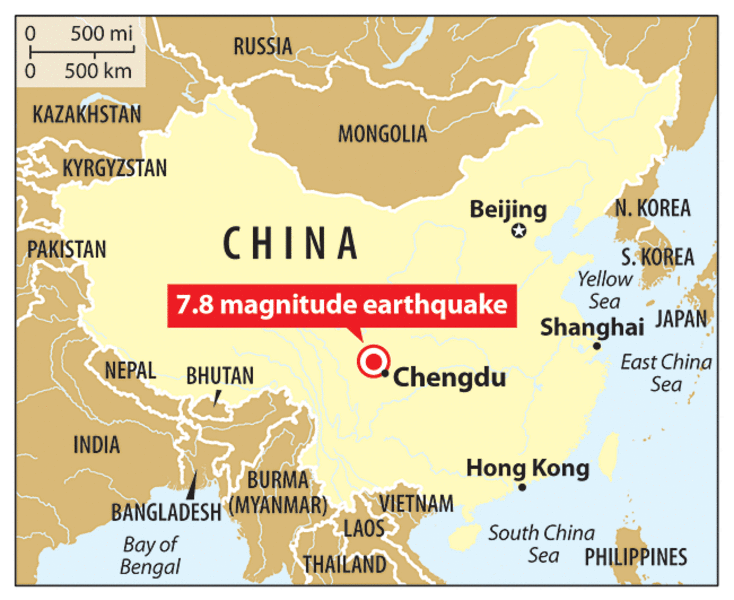China moves quickly in quake zone
Loading...
| Beijing
As the death toll from Monday's earthquake mounted, China threw its Army into rescue operations – reflecting the priority that Beijing has increasingly put on efficient disaster relief.
The country appears to be well prepared for such an operation, says Roger Musson, a seismologist at the British Geological Survey in Edinburgh. "They are very good at putting together a disaster relief plan rather quickly."
More than 6,000 soldiers and militarized police were dispatched to the disaster area, carrying out standing orders in the event of an earthquake, a military spokesman said.
The next few days will reveal to what extent buildings in this part of central China were equipped to withstand a disaster such as this – the country's deadliest since 1976 with at least 8,500 dead as of press time.
Prime Minister Wen Jiabao, who flew to Chengdu, the provincial capital of Sichuan, less than two hours after the quake hit, told reporters en route that government leaders have "asked officials at all levels to be at the front line of the fighting the earthquake and lead the people in their rescue work."
"I believe we can certainly overcome the disaster with the public and the military working together," he added in a televised statement.
Vast improvements in disaster relief
China's annual buffeting from typhoons has led the authorities to build an efficient disaster relief structure, according to Xue Lan, professor of public administration at Beijing's Tsinghua University.
"One dramatic improvement is in life-saving" says Professor Xue. "Death tolls have been falling in recent years even though typhoons have been getting fiercer. China is doing much better than it used to, and than other developing countries [are]."
As well as passing a special law on emergency management last year, setting out the government's responsibilities, China has built a regional network of emergency management offices, reporting to the State Council, which acts as the government's cabinet.
In a Category 1 disaster, as Monday's quake was declared, local officials are authorized to ignore normal chains of command and report directly to the top levels of government, according to Mao Shoulong, professor of public policy at Renmin University in Beijing.
In addition to the thousands of soldiers and police dispatched to the epicenter in Wenchuan county, emergency medical teams were sent from major cities on the east coast to the quake zone.
Their departure displayed a speed of official response that critics said had been lacking during China's last natural disaster, blizzards that gripped the south of the country last January.
A magnitude of 7.8
The epicenter of Monday's 7.8-magnitude earthquake was in Sichuan, about 57 miles northwest of the provincial capital of Chengdu. It hit in the middle of the afternoon – when classes and offices were full.
At one school about 60 miles from the epicenter, nearly 900 students were trapped under rubble, the Associated Press reported, citing Chinese state media. At least seven other schools in the region had collapsed, according to Xinhua, as well as chemical plants and at least one hospital.
As many as 10,000 in Beichuan Qiang Autonomous County were feared injured and 80 percent of the buildings there had been destroyed, Xinhua reported. There had been more than 300 aftershocks, state television said.
Nightfall, severed communications, and blocked roads have hampered rescue efforts. The overall death toll from this earthquake – with tremors reaching as far away as Pakistan, Vietnam and Thailand – is expected to rise in coming days.
"Anything greater than [a magnitude of] 7 is very significant," says Mike Haggerty, a seismologist at the Weston Observatory at Boston College in Weston, Mass. "The magnitude is 7.8, and that's the exactly the same magnitude of the 1976 Tangshen earthquake." About 250,000 people died in that natural disaster thirty years ago.
The key difference between the quakes on Monday and in 1976 was location, says Mr. Musson, the seismologist.
"The 1976 earthquake occurred extremely close to Tangshan. The city was really sitting on top of the fault.... The good aspect is that this occurred in a remote area. The bad aspect is the population has increased," he says.
The shallowness of Monday's earthquake will also contribute to the extent of the damage, Mr. Haggerty warns.
Peter Smith contributed from Boston. Wire material was also used.



